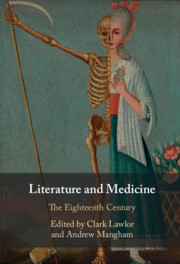Book contents
- Literature and Medicine
- Literature and Medicine
- Copyright page
- Contents
- Figures
- Contributors
- Acknowledgements
- Introduction
- Part I Literary Modes
- Part II Psyche and Soma
- Chapter 4 Mental Illness
- Chapter 5 From Hypo to Bile
- Chapter 6 Metaphors of Infectious Disease in Eighteenth-Century Literature
- Chapter 7 Only Connect
- Part III Professional Identity and Culture
- Index
Chapter 5 - From Hypo to Bile
The Rise and Progress of Biliousness in the Long Eighteenth Century
from Part II - Psyche and Soma
Published online by Cambridge University Press: 03 June 2021
- Literature and Medicine
- Literature and Medicine
- Copyright page
- Contents
- Figures
- Contributors
- Acknowledgements
- Introduction
- Part I Literary Modes
- Part II Psyche and Soma
- Chapter 4 Mental Illness
- Chapter 5 From Hypo to Bile
- Chapter 6 Metaphors of Infectious Disease in Eighteenth-Century Literature
- Chapter 7 Only Connect
- Part III Professional Identity and Culture
- Index
Summary
This chapter elucidates the ways that biliousness, a new fashionable somatic disease of bile, developed out of, and was differentiated from, the older fashionable nervous disease of hypochondria or ‘Hypo’ in the long eighteenth century. Biliousness became not only fashionable in the late eighteenth century but also a mania in the Regency period. Tracing the rise and progress of biliousness, the chapter points to a crucial role played by colonial medicine of the peripheral Indies in forming fashionable bilious identities among people of the metropolitan centre, as well as a critical role that John Abernethy, a fashionable doctor of Regency London, took in making biliousness a mania of the time; his immensely popular writing ‘My Book’ attracted city dwellers, or ‘deskers’, whose livers were affected by mental anxiety. The chapter also argues that literature participated in forming a new type of invalid, the bilious sufferer in the culture of bile or biliousness. Drawing on the literary texts of silver-fork novelists Jane Austen and Thomas De Quincey, this chapter explores the emergence of the medico-literary culture of bile in the last decades of the long eighteenth century, which marks a crucial link between the eighteenth-century malady of ‘Hypo’ and the Victorian malady of dyspepsia.
Keywords
- Type
- Chapter
- Information
- Literature and MedicineThe Eighteenth Century, pp. 113 - 143Publisher: Cambridge University PressPrint publication year: 2021



